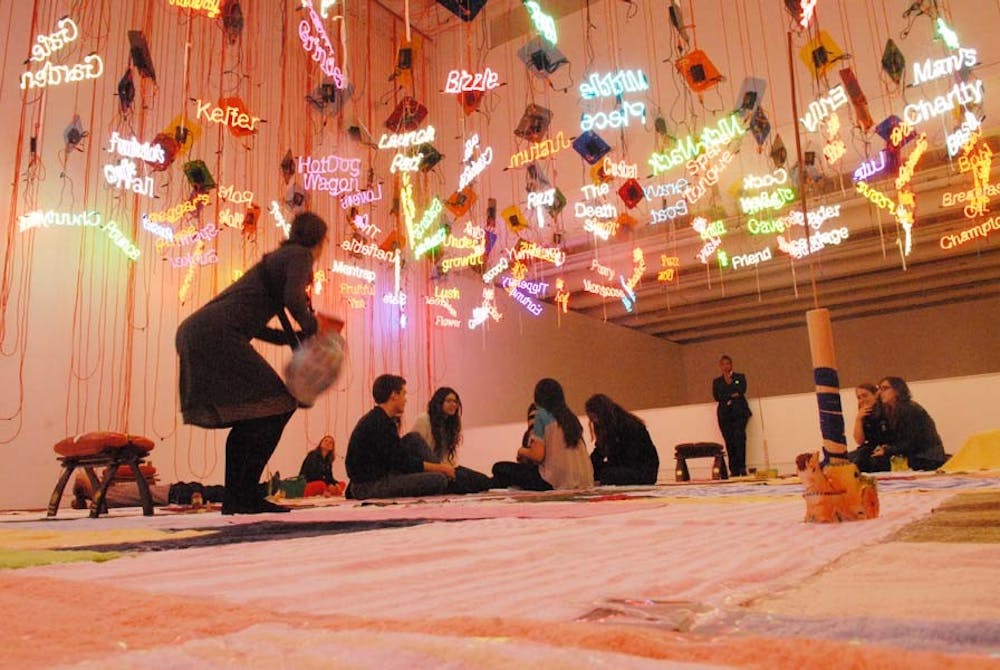
In its 50th year, the Institute of Contemporary Art opened what could be its most ambitious project yet: an exhibit of the works of Jason Rhoades, a renowned installation artist who created massive three-dimensional pieces from 1993 to his untimely death in 2006.
Although Rhoades lived and worked in California, his work has been widely acclaimed throughout Europe and relatively absent within the United States. The exhibit, titled “Jason Rhoades, Four Roads,” which opened last night and will remain at the Institute through Dec. 29, is the first major American exhibition of his art.
Ingrid Shaffner, chief curator of ICA as well as this exhibit, described Rhoades in a keynote speech in celebration of his work as a “perpetual motion machine of creation and creativity.” This persona is clearly visible in the four main works on display, which I was able to view along with a group of ICA members and donors.
Related: Freshman seminar curates ICA exhibit
The entrance to the exhibit was dominated by a makeshift garage, containing a massive Chevrolet engine surrounded by a debris of plastic cups, wires, wood and tools molded out of aluminum foil. Full of references to Rhoades’ years as a student, the piece included pin-up posters and a Formula One racing suit he wore for an earlier performance.
Schaffner described it as one of the many Rhoades’ pieces that “reads like an archaeological site,” full of relics of his past.
“It’s visual poetry, like language expressed in terms of real things,” said Kathy Sachs, former board chair of ICA. “It’s outrageous and exhilarating.”
As Ingrid discussed the garage, I couldn’t help noticing the sound of voices and several discordant tunes echoing from the next room of the exhibit. As we turned the corner, I realized the noises were emanating from The Creation Myth, the exhibit’s largest installation. An artistic representation of the brain, the piece was an overwhelming construction of motion and noise. We walked through a forest of wooden beams papered with pornographic images, while a stuffed snake, cut in half, was propelled around the perimeters of the piece aboard a toy train.
Susie Stamatakos was one of two registrars who participated in the month-long process of unpacking supplies and setting up the exhibit. She considered the most unique aspect of Rhoades’ work to be his use of household objects, such as buckets and empty Snapple bottles. “One of the things I unpacked was a piece of bubble wrap wrapped in bubble wrap, marked: ‘Art. Do not throw away,’” she said.
Related: ICA to offer free admission to all
I nearly tripped over one of the orange power chords littering the ground around a fortress constructed of foldable tables. Metallic domes displayed the distorted reflections of passing viewers, many of whom smiled and shook their heads at the overwhelming installation. I struggled to grasp the full spectrum of ideas being presented as I watched a gigantic tarp balloon inflate and deflate next to a black funnel emitting perfect smoke rings that drifted over the scene.
“I’m a little bit in awe,” said Mary Beth Royal, a sculpture student at Bucks County Community College, as she stared at the piece with wide eyes.
We proceeded up a ramp to the second floor, where a house-shaped structure titled Sutter’s Mill was constructed out of interlocking metallic pipes. Their glistening surfaces reflected hundreds of neon lights — part of another piece, Untitled (from My Madinah: In pursuit of my ermitage…) — that were suspended in the air several yards away. These lights comprised a field of words, each one a different euphemism for “vagina,” which dangled from a lattice of electric cables over a carpet of towels and stools. Viewers were encouraged to take off their shoes and walk beneath the neon sky. Several people laid down on their backs to gaze up at the words as if stargazing.
“It’s interesting how there’s a lot of profanity up in the air, but he also tries to make it very inviting,” said Wharton sophomore Arjan Singh, a member of ICA’s student board. He compared the ironically serene atmosphere of the piece to that of a Sikh temple.
Although many viewers seemed overwhelmed by Rhoades’ bold and intrusive pieces, they still couldn’t deny their power.
“It’s hard to find a vocabulary to talk about it,” said Janice Volkman, one of the many adults attracted to the exhibit’s grand opening. “Beautiful isn’t the right word… it’s startling.”
This article has been revised to reflect that Shaffer is not only the chief curator of “Jason Rhoades, Four Roads,” but also of ICA.
The Daily Pennsylvanian is an independent, student-run newspaper. Please consider making a donation to support the coverage that shapes the University. Your generosity ensures a future of strong journalism at Penn.
DonatePlease note All comments are eligible for publication in The Daily Pennsylvanian.




